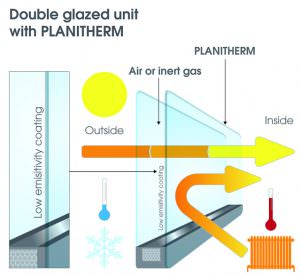Double & Triple glazing sealed units
Double glazing has changed dramatically over the last few years, from the original two sheets of float glass with a very small spacer bar to today’s high spec double & Triple glazed sealed units.
Double glazed sealed units are constructed of two pieces of glass bonded together the double glazing glass panes are kept apart by a spacer bar (available in various sizes that determine the size of the unit) which contains hundreds of tiny silica balls. These same balls can be found in the little bags you find in the packages when you buy electrical goods to keep then dry and free from moisture. It is these balls which soak up any moisture which exists in the air gap between the two panes of glass. They are sealed together with a flexible sealant to the outside. Still air remains between the panes of glass that acts as the thermal barrier. These are called standard insulated units. These can incorporate various sizes of different glass, can be toughened, decorative effects can be added even the glass upgraded for increased thermal efficiency.
RECENT LEGISLATION NOW STATES THAT IT IS COMPULSORY THAT ALL NEW & REPLACEMENT WINDOWS & DOORS ARE ENERGY RATED:

Heat losses can be compared by their U values. The higher the U value the greater the heat loss.
Ordinary glass has a U value of 2.8 and double glazing with Pilkington K has a U value of only 1.9 which is considerably better than conventional double glazing.
This can be improved on by the use of Argon gas filled units. Or alternative Low E glass like Planitherm coupled with Argon gas can bring the U value down to 1.1
One of the best known products being Pilkington K low emissivity coated glass (the coating being sandwiched between the cavity) since then various manufactures have introduced equivalent products Planitherm, Guardian to name but a few, they all work on the principle of reflecting generated heat back into the room and allow solar radiation to warm the panes from outside.
What is Energy Efficient Glass?
A staggering 26% of all domestic heat loss escapes through the windows*. Installing energy efficient windows can save you up to 28% per year on your heating bills compared to traditional windows and frames. use energy efficient glass?
Due to the importance placed on the damage to the environment in recent years, as part of the Kyoto agreement, the Government has committed to reduce the amount of greenhouse gases the UK produces. One way has been through stricter Building Regulations concerning energy efficiency.
New regulations will soon be in force where the whole window will have an energy rated certificate.
By far one of the most influential effects of this will be the glass areas; with new advanced technology this makes way for a complete new Hybrid double glazed sealed unit.
Low emissivity’ (Low-e) glass
Low emissivity’ (Low-e) glass such as Planitherm & Pilkington K Glass is designed to reflect heat from fires and radiators back into your home, greatly improving its thermal efficiency. At the same time, it allows heat from the sun through your window, contributing to its energy efficiency. By using less heat to keep your home warm, less energy needs to be produced, therefore lowering the overall levels of greenhouse gases and the cost of keeping your home warm.
Argon Gas
Argon is a colourless, odourless, non-flammable, non-reactive, inert gas. Argon gas fills are used to reduce heat loss in Double & Triple glazing sealed units by slowing down convection inside the air space. Argon gas is extremely cost-efficient, and works well with Low-e coated glazing. When we talk about insulation glass without low-e coating, we refer to glass that uses air between panes as a primary source of insulation. As air itself is a good insulator, filling the gap between the glass panes with a low-conductivity gas such as argon improves window performance by reducing conductive and convective heat transfers. This phenomenon results from the fact that the density of the gas is greater than the density of the air. Argon is the most commonly used fill gas, due to its excellent thermal performance and cost-efficiency in comparison to other gas fills.
Spacer Bars
Older style spacer bars were manufactured from aluminium or pressed steel these sometimes had the effect of allowing a cold bridge across the panes of glass sometimes showing a line of condensation to the edge of the sealed unit.
Modern products now include, thermal break bars, super spacer bars, warm edge, or carbon spacers all giving the same strength but with increased thermal insulation as they become more popular hopefully the prices will fall. There are many other benefits of installing windows with Super Spacer. It reduces condensation by up to 70%, virtually eliminating the potential breeding ground for bacteria, mould and dust mites that can be harmful to people with respiratory diseases. Super Spacer also reduces noise transmission by up to 2dB which helps you keep your home away from the noise of the outside world.
Why use energy efficient glass?
Research has shown that many homeowners assume that all double glazing is equally energy efficient. In fact, there are huge differences in performance and it is the glass that makes the difference. **
![]() Free Solar Heat Gain
Free Solar Heat Gain
PLANITHERM uses advanced coating technology to capture free energy from natural daylight to help heat the home
![]() Thermal Insulation
Thermal Insulation
The advanced coating reflects heat back into the room, meaning less energy is needed to heat the home to the desired temperature
![]() Optimal Energy Ratings
Optimal Energy Ratings
PLANITHERM combines with virtually any window frame to achieve a Window Energy Rating (WER) of C and an A rating is easier to achieve
![]() Haze & Tint Free Windows
Haze & Tint Free Windows
PLANITHERM maximises the amount of natural light into the home, without the haze or tint effects associated with some older double glazed windows
![]() Eliminate Condensation
Eliminate Condensation
PLANITHERM helps to virtually eliminate internal condensation and reduce draughts and cold spots in and around windows
Cristal Windows are members of the
PLANITHERM INSTALLERS NETWORK:
We specify Planitherm glass as standard in our sealed units.
What is PLANITHERM?
PLANITHERM is a new generation of energy saving window glass that uses advanced coatings to retain more internal warmth whilst capturing free energy from natural daylight.
Using PLANITHERM, you can have A rated windows installed for around the same cost as less energy efficient windows. A staggering 26% of all domestic heat loss escapes through the windows*. Installing A rated energy efficient windows can save you up to 28% per year on your heating bills compared to traditional windows and frames.
If you are planning to replace your existing single glazed or double glazed windows, and you want the best possible choice for energy savings, ask us for PLANITHERM.
How does PLANITHERM work?
PLANITHERM products use a special coating to reflect heat from domestic heat sources back into the room, rather than allowing it to escape outside through the windows. In addition to this, the coating allows free heat and light from the sun to pass through the glass, warming the room and further contributing to the energy efficiency of the windows and helping to reduce your energy bills.
This combination of unrivalled thermal insulation with high solar heat gain makes PLANITHERM the most energy efficient window glass available and the best possible choice for energy savings.
If you install windows with PLANITHERM your home will be lighter, brighter, warmer and more energy efficient thanks to the advanced thermal insulation of PLANITHERM.
How can PLANITHERM benefit you?
 Free Solar Heat Gain – PLANITHERM has a unique coating which captures free energy from natural daylight to heat the home.
Free Solar Heat Gain – PLANITHERM has a unique coating which captures free energy from natural daylight to heat the home.
Thermal Insulation – The coating reflects heat back into the room, helping to keep the room warmer and reduce heating bills.
Optimal Energy Ratings – As PLANITHERM is the most energy-efficient glass available, A-rated windows can be achieved using energy-efficient frames.
Haze and Tint free windows – PLANITHERM maximizes natural light entering the home without the tint or haze effects associated with some other double-glazed windows.
Eliminates Condensation – PLANITHERM helps to reduce draughts and cold spots around windows and helps to virtually eliminate internal condensation.
With so much glass around us we must think of safety
On impact conventional float glass breaks into large shrouds.
Different types of glass can be classified as safety glass
| Toughened Glass (also called tempered) categorised as Class A | This looks like ordinary glass but receives a special heat treatment process to toughen it. It is much stronger than ordinary glass and on impact disintegrates into small granular pieces, which are not sharp, reducing the risk of injury. |
| Laminated Glass available in Class A, B or C | Consists of two or more sheets of ordinary glass which are attached together by a plastic interlayer. The plastic layer provides a barrier and on impact any broken shards of glass will remain attached to the plastic reducing the risk of injury. |
| Wired Glass (also called Pyroshield safety clear/textured) categorised as Class C | This glass has a network/mesh of wires embedded in it. Certain types of wired glass can satisfy the impact requirements for safety glass while giving a level of fire resistance. |
| Plastics Glazing Sheet | Certain types of transparent plastic sheet can satisfy the impact requirements for safety glass. Please Note: Glass in doors and side panels may only be glazed in Class C materials where the smaller dimension is a maximum of 900mm. Where this dimension is greater than 900mm glazing categorised as Class A or B is required |
EXAMPLES OF LOCATIONS
The diagram below gives examples of glazing in windows, partitions, walls, doors and side panels. ‘Critical locations’ are shaded grey. Any glazing within a shaded area must comply with BS 6206.
In the diagram glazing unit No. 10 falls wholly within a ‘critical location’ and so the glazing must comply with BS 6206.
Where only part of a glazing unit falls within a ‘critical location’ the whole of that unit must comply with BS 6206. In Diagram 1 this applies to units Nos. 2, 3, 5, 6, 7, 9, 11 and 12.
Only glazing units Nos. 1, 4 and 8 fall wholly outside the ‘critical location’ and need not comply with BS 6206.
Glazing in Windows, Partitions Glazing in Doors and Side Panels and Walls
Where only part of a unit contains a shaded location the whole of that unit must comply with BS 6206.






